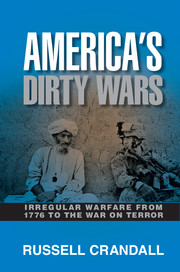Book contents
- Frontmatter
- Dedication
- Contents
- List of Figures
- Acknowledgments
- 1 Introduction
- 2 Irregular Warfare 101
- Part One The American Revolution to Chasing Sandino, 1776–1930s
- Part Two The Cold War, 1940s–1989
- Part Three Latin America and the Cold War, 1950s–1980s
- 20 From Guatemala, 1954, to Cuba and the Bayof Pigs, 1961
- 21 Guatemala, Post-1963
- 22 Cuba, Post-1963
- 23 Intermezzo
- 24 Carter, Reagan, and the Sandinista Revolution in Nicaragua, 1979–1990
- 25 El Salvador, 1979–1992
- Part Four Post–Cold War, 1990s–2000s
- Notes
- Bibliography
- Index
24 - Carter, Reagan, and the Sandinista Revolution in Nicaragua, 1979–1990
Published online by Cambridge University Press: 05 July 2014
- Frontmatter
- Dedication
- Contents
- List of Figures
- Acknowledgments
- 1 Introduction
- 2 Irregular Warfare 101
- Part One The American Revolution to Chasing Sandino, 1776–1930s
- Part Two The Cold War, 1940s–1989
- Part Three Latin America and the Cold War, 1950s–1980s
- 20 From Guatemala, 1954, to Cuba and the Bayof Pigs, 1961
- 21 Guatemala, Post-1963
- 22 Cuba, Post-1963
- 23 Intermezzo
- 24 Carter, Reagan, and the Sandinista Revolution in Nicaragua, 1979–1990
- 25 El Salvador, 1979–1992
- Part Four Post–Cold War, 1990s–2000s
- Notes
- Bibliography
- Index
Summary
If any nation, whatever its political system, deprives its people of basic human rights, that fact will help shape our own people’s attitude toward that nation’s repressive government. . . . [W]e should use our tremendous influence to increase freedom, particularly in those countries that depend upon us for their very survival.
– President Jimmy Carter during the 1978 presidential campaignIn the early morning of January 10, 1978, Pedro Joaquín Chamorro, a prominent Nicaraguan political figure and head of the opposition newspaper La Prensa, was driving in Managua when a green Toyota truck suddenly swerved in front of him. Two men leaped out of the truck and fired shotgun blasts at Chamorro’s vehicle, then jumped into a waiting car and sped away. Chamorro was rushed to a nearby hospital but died on the way. Nicaragua’s strongman, Anastasio “Tachito” Somoza, the second son of the Somoza who killed the nationalist guerrilla Sandino and seized power in the early 1930s, claimed that the assassination had been perpetrated by opposition members themselves to implicate the increasingly despised regime.
Few Nicaraguans believed this version of the story. Instead, they blamed Somoza for the extrajudicial killing, and their eagerness to get rid of the dynastic dictatorship increased significantly. In the aftermath of Chamorro’s public funeral, youth in cities across the country tossed homemade bombs at military jeeps and shot at National Guard posts with hunting rifles. In their first coordinated anti-Somoza move, business leaders called a national strike demanding that Chamorro’s killers be found and tried. Chamorro’s death became the spark for the conflagration that sealed Somoza’s dramatic downfall and initiated a Marxist revolution in Nicaragua.
- Type
- Chapter
- Information
- America's Dirty WarsIrregular Warfare from 1776 to the War on Terror, pp. 280 - 303Publisher: Cambridge University PressPrint publication year: 2014



